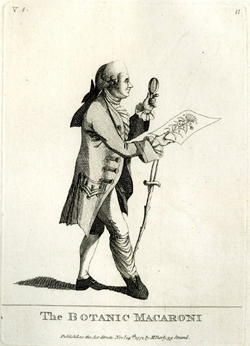Macaroni Prints
Matthew and Mary Darly were the principal purveyors of the portrait caricatures now generally known as "macaroni" prints. Their shop is, in fact, pictured in The Macaroni Print Shop [1772] by Edward Topham. Their windows became a public display case for the general populace while their shop became a meeting place for both the subjects and patrons of these prints. The prints were initially sold separately, but demand was such that they were then bound up into collections and sold or rented to patrons who wanted to survey and laugh at a more comprehensive macaroni world.

The Botanic Macaroni [1772]
© Trustees of the British Museum
The Botanic Macaroni was plate 11 of volume 5 of Caricatures, Macaronies & Characters published in 1772-3. The subjects of macaroni prints as of most portrait caricatures were seldom named, but the title and other physical details in the prints were usually sufficient to identify them for the elite who bought or borrowed them.
In this case, according to M. Dorothy George, the print shows the Botanist Joseph Banks. Banks had become famous as part of Captain Cook's voyage to Brazil, Tahiti, and New Zealand (1768-1771). He wrote descriptions of hundreds of hitherto unknown plants, including the now common bougainvillea. He later became an advisor to King on the Royal Botanical Gardens at Kew. He suffered from gout nearly every winter for most of his life. Hence the swathed and swollen leg in the print.
When the King made Banks a member of the Order of Bath some 20 years later, Gillray caricatured him in The Great South Sea Caterpillar, Transform'd into a Bath Butterfly (1795).